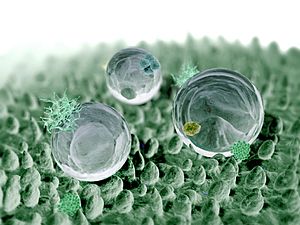Bionics facts for kids

Bionics (also called biomimetics) is a cool science. It's all about studying nature to create amazing new technology. Think of it as learning from plants and animals to solve human problems.
Contents
History of Bionics
The idea of biomimetics was first named by Otto Schmitt in the 1950s. The word bionics was created by Jack E. Steele in 1958. He was working at an Air Force base in Ohio at the time.
Today, many people prefer to use biomimetics or biomimicry. This helps avoid confusion with the medical use of "bionics." The word "bionics" also became famous from the 1972 novel Cyborg. This book later inspired the TV show The Six Million Dollar Man.
How Bionics Works

Bionics often focuses on how things in nature work, not just how they look. For example, in computer science, cybernetics tries to copy how living things control themselves. Artificial intelligence tries to make computers think like humans.
Scientists see nature as a huge library of solutions. Over millions of years, evolution has made natural designs very efficient. This means nature has already tested and perfected many ideas.
While many types of engineering use ideas from nature, the modern field of biomimicry grew from the work of Buckminster Fuller. Later, Janine Benyus helped make it a well-known area of study.
Scientists often look at three main levels in nature for inspiration:
- Copying natural ways of making things.
- Imitating mechanisms found in nature, like how Velcro works.
- Studying how groups of organisms behave. This includes how birds flock or how ants and bees find food.
Cool Examples of Bionics
- In robotics, bionics helps design robots that move like animals. The BionicKangaroo, for example, moves just like a real kangaroo.
- Velcro is a super famous example! In 1948, a Swiss engineer named Georges de Mestral was cleaning burrs off his dog. He noticed how the tiny hooks on the burrs stuck to the dog's fur. This gave him the idea for Velcro.
- Early lumberjack saw blades were designed like a wood-boring beetle's horn. This made cutting down trees much faster.
- Cat's eye reflectors for roads were invented by Percy Shaw in 1935. He studied how cats' eyes reflect light, even tiny amounts.
- Leonardo da Vinci's designs for flying machines and ships were early examples of using nature for engineering.
- Resilin is a rubber-like material. It was created by studying a similar material found in insects.
- In 2004, Julian Vincent developed "smart" clothing. It changes shape with temperature, just like pinecones open and close based on moisture.
- "Morphing aircraft wings" were designed in 2004 by scientists at Pennsylvania State University. These wings change shape during flight, inspired by different bird wings. They even used fish-inspired scales for the wing's skin!
- Some paints and roof tiles are now self-cleaning. They copy the way the lotus leaf cleans itself.
- Cholesteric liquid crystals (CLCs) are used in things like fish tank thermometers. They change color with temperature, just like some natural structures.
- The amazing shining colors of butterfly wings come from tiny structures, not pigments. Scientists have copied these structures to create new technologies.
- The blue morpho butterfly's wing structure inspired an RFID tag that can be read through water and on metal.
- Butterfly wings have also inspired tiny new sensors that can detect explosives.
- Neuromorphic chips are computer chips that work like real brain cells.
- The cooling system of the Eastgate Centre building in Zimbabwe was designed like a termite mound. This makes it very energy efficient.
- Scientists are developing strong glues inspired by how mussels stick to rocks underwater.
- New aircraft designs are being created based on how birds fly. This could lead to faster, more agile planes and even tiny UAVs (drones) for spying.
Bionics in Medicine
In medicine, bionics means replacing or improving body parts with mechanical versions. Bionic implants are different from simple prosthetics. They try to copy the original body part's function very closely, or even make it better!
While these technologies are still quite new, some bionic items already exist. The most famous is the cochlear implant. This device helps deaf people hear. By 2004, fully working artificial hearts were also developed.
Scientists expect even more progress with nanotechnology. For example, a "respirocyte" is a proposed artificial red blood cell. It could carry oxygen much more efficiently than natural red blood cells.
Kwabena Boahen developed a silicon retina that works like a real eye. He compared its electrical signals to a salamander eye to prove it.
In 2007, a company called Touch Bionics launched the "i-Limb Hand." This was the first bionic hand available for people to buy. By 2010, over 1,200 patients worldwide had received one.
In 2015, surgeons in Manchester performed the first bionic eye implant for a patient with common sight loss. The implant, called the Argus II, helps patients see light and shapes.
Other Uses of Bionics
Business biomimetics is a newer idea. It applies lessons from nature to how businesses are run. This can help companies with their plans, how they work, and how they are organized.
Bionics can also be a technique to get new ideas for engineering. Since nature has optimized many designs through evolution, it's a great source of inspiration.
Another meaning of bionics is merging living things with machines. This creates a cybernetic organism (or cyborg). For example, scientist Kevin Warwick had an implant that allowed him to sense ultrasound directly through his nervous system.
See also
 In Spanish: Biónica para niños
In Spanish: Biónica para niños


